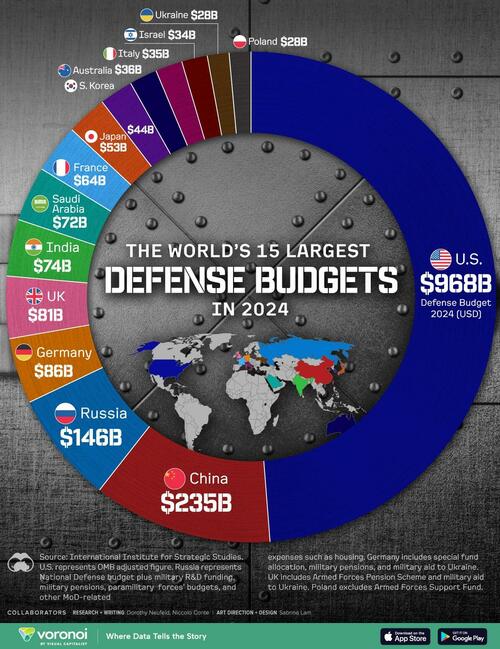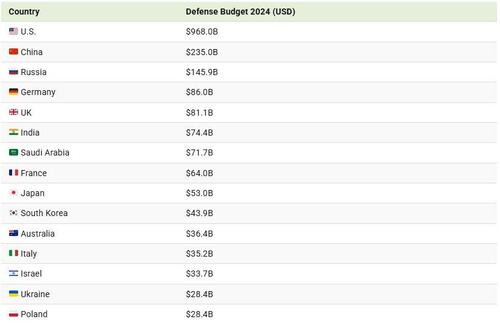In 2024, the U.S. spent nearly $1 trillion on its defense budget, equal to 3.4% of GDP.
In contrast, NATO members in Europe and Canada spent an average of 2% of GDP on defense. While NATO’s defense budgets have declined since the Cold War, Russia’s military spending has surged by 227% since 2000, and China’s has skyrocketed by 566%.
This graphic, via Visual Capitalist's Dorothy Neufeld, shows the top 15 largest defense budgets in 2024, based on data from the International Institute of Strategic Studies.
Here are the largest defense budgets worldwide, illustrating America’s continued dominance of hard power amid unfolding geopolitical conflicts:
U.S. represents OMB adjusted figure. Russia represents National Defense budget plus military R&D funding, military pensions, paramilitary forces’ budgets, and other MoD-related expenses such as housing. Germany includes special fund allocation, military pensions, and military aid to Ukraine. UK includes Armed Forces Pension Scheme and military aid to Ukraine. Poland excludes Armed Forces Support Fund.
As the above table shows, the U.S. spends as much as the next 12 largest defense budgets combined.
Today, just five prime contractors receive 86% of the Pentagon’s spending compared to 51 contractors being allocated 6% of defense spending at the end of the Cold War. Arguably, this concentration has fostered overspending and lower productivity gains.
In an era of all things new, the Trump administration has fired senior leaders in the military, navy, coast guard, and air force. Senior lawyers were abruptly let go too. Overall, the Pentagon could shed 8% of its personnel.
Ranking in second is China, with a $235 billion defense budget. Yet on a purchasing power parity basis, it stands at $477 billion when adjusting for lower costs in China. Overall, the country’s military modernization includes 600 operational nuclear warheads that are projected to reach 1,000 by 2030 as the country increasingly focuses on reunification with Taiwan.
Russia has the third-largest defense budget globally, at $146 billion, representing 6% of the country’s national income—the highest share since the Cold War. Like China, this figure is much higher in real purchasing power terms, rising to $461 billion. Today, Russia’s nuclear arsenal rivals the U.S. with 5,000 warheads, despite being a medium-sized economy.
To learn more about this topic from a U.S. military perspective, check out this graphic on all of America’s military bases worldwide.

